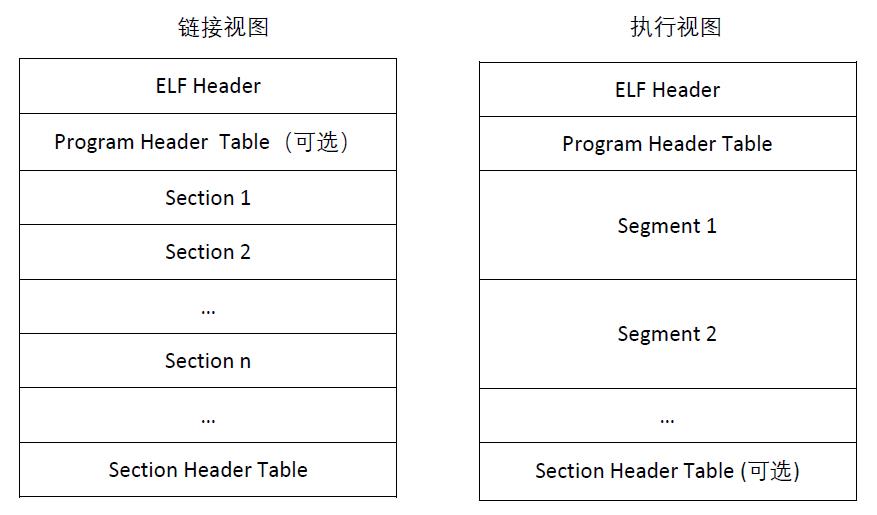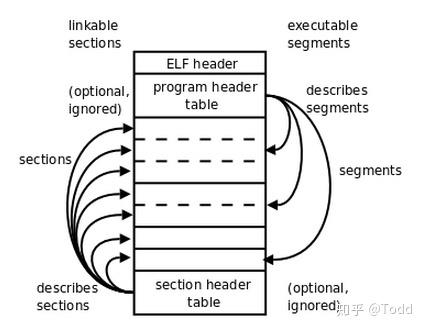编译链接实战认识elf文件格式
Posted 奇妙之二进制
tags:
篇首语:本文由小常识网(cha138.com)小编为大家整理,主要介绍了编译链接实战认识elf文件格式相关的知识,希望对你有一定的参考价值。
🎀 关于博主👇🏻👇🏻👇🏻
🥇 作者简介: 热衷于知识探索和分享的技术博主。
💂 csdn主页::【奇妙之二进制】
✍️ 微信公众号:【Linux 世界】🎉精彩专栏:
🎓 【面向工作git基础教程】
🧡 【C++11新特性深入剖析】
📚【shell脚本编程基础与实战】
🌎【Linux网络编程面试演练】
✍️ 【C++编译工具cmake入门到精通】
…💂关于作者: 曾就职于国内知名安防上市公司,现就职于国内知名AMR机器人公司,担任高级系统软件工程师。2020年至今保持CSDN博客专家,CSDN C/C++领域优质创作者头衔。全网5万+粉丝。十载寒冰,难凉热血;多年过去,历经变迁,物是人非。 然而,对于技术的探索和追求从未停歇。 💪坚持创作,热衷分享,初心未改,继往开来!
文章目录
1、ELF文件简介
首先,你需要知道的是所谓对象文件(Object files)有三个种类:
可重定位的对象文件(Relocatable file)
这是由汇编器汇编生成的 .o 文件。后面的链接器(link editor)拿一个或一些 Relocatable object files 作为输入,经链接处理后,生成一个可执行的对象文件 (Executable file) 或者一个可被共享的对象文件(Shared object file)。我们可以使用 ar 工具将众多的 .o Relocatable object files 归档(archive)成 .a 静态库文件。另外,可以预先告诉大家的是我们的内核可加载模块 .ko 文件也是 Relocatable object file。
可执行的对象文件(Executable file)
这我们见的多了。文本编辑器vi、调式用的工具gdb、播放mp3歌曲的软件mplayer等等都是Executable object file。你应该已经知道,在我们的 Linux 系统里面,存在两种可执行的东西。除了这里说的 Executable object file,另外一种就是可执行的脚本(如shell脚本)。注意这些脚本不是 Executable object file,它们只是文本文件,但是执行这些脚本所用的解释器就是 Executable object file,比如 bash shell 程序。
可被共享的对象文件(Shared object file)
这些就是所谓的动态库文件,也即 .so 文件。如果拿前面的静态库来生成可执行程序,那每个生成的可执行程序中都会有一份库代码的拷贝。如果在磁盘中存储这些可执行程序,那就会占用额外的磁盘空间;另外如果拿它们放到Linux系统上一起运行,也会浪费掉宝贵的物理内存。如果将静态库换成动态库,那么这些问题都不会出现。动态库在发挥作用的过程中,必须经过两个步骤:
a) 链接编辑器(link editor)拿它和其他Relocatable object file以及其他shared object file作为输入,经链接处理后,生成另外的 shared object file 或者 executable file。
b)在运行时,动态链接器(dynamic linker)拿它和一个Executable file以及另外一些 Shared object file 来一起处理,在Linux系统里面创建一个进程映像。
2、ELF文件格式
首先,ELF文件格式提供了两种视图,分别是链接视图和执行视图。

合并成一张图:

链接视图是以节(section)为单位,执行视图是以段(segment)为单位。链接视图就是在链接时用到的视图,而执行视图则是在执行时用到的视图。上图左侧的视角是从链接来看的,右侧的视角是执行来看的。整个文件可以分为四个部分:
- ELF header:elf文件头部信息,描述整个文件的组织。
- Program Header Table: 描述文件中的各种segments, 每个segment都用一个表项来描述,表项记录了该segment在文件中的起始地址,以及大小等信息。这些表项(entry)就构成了程序头表。你可以理解成一个结构体数组。用来告诉系统如何创建进程映像。
- sections 或者 segments:segments是从运行的角度来描述elf文件,sections是从链接的角度来描述elf文件,也就是说,在链接阶段,我们可以忽略program header table来处理此文件,在运行阶段可以忽略section header table来处理此程序(所以很多加固手段删除了section header table)。从图中我们也可以看出,segments与sections是包含的关系,一个segment包含若干个section。
- Section Header Table: 每个section都用一个表项来描述,表项记录了该section在文件中的起始地址,以及大小等信息。这些表项(entry)就构成了节头表。你可以理解成一个结构体数组。
备注:下面开始section翻译成节,segment翻译成段。
3、分析ELF文件头
vi /usr/include/elf.h查看elf头数据结构:
/* The ELF file header. This appears at the start of every ELF file. */
#define EI_NIDENT (16)
typedef struct
unsigned char e_ident[EI_NIDENT]; /* Magic number and other info */
Elf32_Half e_type; /* Object file type */
Elf32_Half e_machine; /* Architecture */
Elf32_Word e_version; /* Object file version */
Elf32_Addr e_entry; /* Entry point virtual address */
Elf32_Off e_phoff; /* Program header table file offset */
Elf32_Off e_shoff; /* Section header table file offset */
Elf32_Word e_flags; /* Processor-specific flags */
Elf32_Half e_ehsize; /* ELF header size in bytes */
Elf32_Half e_phentsize; /* Program header table entry size */
Elf32_Half e_phnum; /* Program header table entry count */
Elf32_Half e_shentsize; /* Section header table entry size */
Elf32_Half e_shnum; /* Section header table entry count */
Elf32_Half e_shstrndx; /* Section header string table index */
Elf32_Ehdr;
typedef struct
unsigned char e_ident[EI_NIDENT]; /* Magic number and other info */
Elf64_Half e_type; /* Object file type */
Elf64_Half e_machine; /* Architecture */
Elf64_Word e_version; /* Object file version */
Elf64_Addr e_entry; /* Entry point virtual address */
Elf64_Off e_phoff; /* Program header table file offset */
Elf64_Off e_shoff; /* Section header table file offset */
Elf64_Word e_flags; /* Processor-specific flags */
Elf64_Half e_ehsize; /* ELF header size in bytes */
Elf64_Half e_phentsize; /* Program header table entry size */
Elf64_Half e_phnum; /* Program header table entry count */
Elf64_Half e_shentsize; /* Section header table entry size */
Elf64_Half e_shnum; /* Section header table entry count */
Elf64_Half e_shstrndx; /* Section header string table index */
Elf64_Ehdr;
可以通过readelf -h查看程序elf头:
root@AI-Machine:/home/hongjh/2019_project# readelf -h a.out
ELF Header:
Magic: 7f 45 4c 46 01 01 01 00 00 00 00 00 00 00 00 00
Class: ELF32
Data: 2's complement, little endian
Version: 1 (current)
OS/ABI: UNIX - System V
ABI Version: 0
Type: EXEC (Executable file)
Machine: Intel 80386
Version: 0x1
Entry point address: 0x8048340
Start of program headers: 52 (bytes into file)
Start of section headers: 6144 (bytes into file)
Flags: 0x0
Size of this header: 52 (bytes)
Size of program headers: 32 (bytes)
Number of program headers: 9
Size of section headers: 40 (bytes)
Number of section headers: 31
Section header string table index: 28
上面指示了节头表、程序头表在文件的偏移,有多少表项,每个表项的大小,程序的运行平台,大小端,文件类型(可执行文件EXEC、可重定位文件REL、共享目标文件DYN),是32位还是64位。
Entry point address表示该程序在内存的入口地址,即加载地址。
Machine指示了该文件的平台。
ELF header的定义可以在 /usr/include/elf.h 中找到。Elf32_Ehdr是32位 ELF header的结构体。Elf64_Ehdr是64位ELF header的结构体。
/* Section header. */
typedef struct
Elf32_Word sh_name; /* Section name (string tbl index) */
Elf32_Word sh_type; /* Section type */
Elf32_Word sh_flags; /* Section flags */
Elf32_Addr sh_addr; /* Section virtual addr at execution */
Elf32_Off sh_offset; /* Section file offset */
Elf32_Word sh_size; /* Section size in bytes */
Elf32_Word sh_link; /* Link to another section */
Elf32_Word sh_info; /* Additional section information */
Elf32_Word sh_addralign; /* Section alignment */
Elf32_Word sh_entsize; /* Entry size if section holds table */
Elf32_Shdr;
typedef struct
Elf64_Word sh_name; /* Section name (string tbl index) */
Elf64_Word sh_type; /* Section type */
Elf64_Xword sh_flags; /* Section flags */
Elf64_Addr sh_addr; /* Section virtual addr at execution */
Elf64_Off sh_offset; /* Section file offset */
Elf64_Xword sh_size; /* Section size in bytes */
Elf64_Word sh_link; /* Link to another section */
Elf64_Word sh_info; /* Additional section information */
Elf64_Xword sh_addralign; /* Section alignment */
Elf64_Xword sh_entsize; /* Entry size if section holds table */
Elf64_Shdr;
4、节头表Section Header Table
上面提到节头表就是一个结构体数组,该结构体定义如下:
typedef struct
Elf64_Word sh_name; /* Section name (string tbl index) */
Elf64_Word sh_type; /* Section type */
Elf64_Xword sh_flags; /* Section flags */
Elf64_Addr sh_addr; /* Section virtual addr at execution */
Elf64_Off sh_offset; /* Section file offset */
Elf64_Xword sh_size; /* Section size in bytes */
Elf64_Word sh_link; /* Link to another section */
Elf64_Word sh_info; /* Additional section information */
Elf64_Xword sh_addralign; /* Section alignment */
Elf64_Xword sh_entsize; /* Entry size if section holds table */
Elf64_Shdr;
一个ELF文件中到底有哪些具体的section,由包含在这个ELF文件的section head table(SHT)决定。在SHT中,针对每一个section,都设置一个条目,用来描述对应的这个section,其内容主要包括该section的名称、类型、大小以及在整个ELF文件中的字节偏移位置等等。
使用readelf -S a.out读取节头表:
root@AI-Machine:/home/hongjh/2019_project# readelf -S a.out
There are 31 section headers, starting at offset 0x1800:
Section Headers:
[Nr] Name Type Addr Off Size ES Flg Lk Inf Al
[ 0] NULL 00000000 000000 000000 00 0 0 0
[ 1] .interp PROGBITS 08048154 000154 000013 00 A 0 0 1
[ 2] .note.ABI-tag NOTE 08048168 000168 000020 00 A 0 0 4
[ 3] .note.gnu.build-i NOTE 08048188 000188 000024 00 A 0 0 4
[ 4] .gnu.hash GNU_HASH 080481ac 0001ac 000020 04 A 5 0 4
[ 5] .dynsym DYNSYM 080481cc 0001cc 000060 10 A 6 1 4
[ 6] .dynstr STRTAB 0804822c 00022c 000052 00 A 0 0 1
[ 7] .gnu.version VERSYM 0804827e 00027e 00000c 02 A 5 0 2
[ 8] .gnu.version_r VERNEED 0804828c 00028c 000020 00 A 6 1 4
[ 9] .rel.dyn REL 080482ac 0002ac 000008 08 A 5 0 4
[10] .rel.plt REL 080482b4 0002b4 000018 08 AI 5 24 4
[11] .init PROGBITS 080482cc 0002cc 000023 00 AX 0 0 4
[12] .plt PROGBITS 080482f0 0002f0 000040 04 AX 0 0 16
[13] .plt.got PROGBITS 08048330 000330 000008 00 AX 0 0 8
[14] .text PROGBITS 08048340 000340 0001a2 00 AX 0 0 16
[15] .fini PROGBITS 080484e4 0004e4 000014 00 AX 0 0 4
[16] .rodata PROGBITS 080484f8 0004f8 000008 00 A 0 0 4
[17] .eh_frame_hdr PROGBITS 08048500 000500 00002c 00 A 0 0 4
[18] .eh_frame PROGBITS 0804852c 00052c 0000cc 00 A 0 0 4
[19] .init_array INIT_ARRAY 08049f08 000f08 000004 00 WA 0 0 4
[20] .fini_array FINI_ARRAY 08049f0c 000f0c 000004 00 WA 0 0 4
[21] .jcr PROGBITS 08049f10 000f10 000004 00 WA 0 0 4
[22] .dynamic DYNAMIC 08049f14 000f14 0000e8 08 WA 6 0 4
[23] .got PROGBITS 08049ffc 000ffc 000004 04 WA 0 0 4
[24] .got.plt PROGBITS 0804a000 001000 000018 04 WA 0 0 4
[25] .data PROGBITS 0804a018 001018 000008 00 WA 0 0 4
[26] .bss NOBITS 0804a020 001020 000004 00 WA 0 0 1
[27] .comment PROGBITS 00000000 001020 000035 01 MS 0 0 1
[28] .shstrtab STRTAB 00000000 0016f6 00010a 00 0 0 1
[29] .symtab SYMTAB 00000000 001058 000460 10 30 47 4
[30] .strtab STRTAB 00000000 0014b8 00023e 00 0 0 1
Key to Flags:
W (write), A (alloc), X (execute), M (merge), S (strings)
I (info), L (link order), G (group), T (TLS), E (exclude), x (unknown)
O (extra OS processing required) o (OS specific), p (processor specific)
该程序一共有31个节,第0个节通常是个空节。这里有我们熟悉的:
[14] .text PROGBITS 08048340 000340 0001a2 00 AX 0 0 16
[16] .rodata PROGBITS 080484f8 0004f8 000008 00 A 0 0 4
[25] .data PROGBITS 0804a018 001018 000008 00 WA 0 0 4
[26] .bss NOBITS 0804a020 001020 000004 00 WA 0 0 1
-
.text section 里装载了可执行代码;
-
.data section 里面装载了被初始化的数据;
-
.bss section 里面装载了未被初始化的数据;
-
以 .rec 打头的 sections 里面装载了重定位条目;
-
.symtab 或者 .dynsym section 里面装载了符号信息;
-
.strtab 或者 .dynstr section 里面装载了字符串信息;
-
其他还有为满足不同目的所设置的section,比方满足调试的目的、满足动态链接与加载的目的等等。
关于这些section的细节,后面再深入。
5、程序头表Program Header Table
程序头部(Program Header)描述与程序执行直接相关的目标文件结构信息。用来定位各个段(segment)的映像。同时包含其他一些用来为程序创建映像所必须的信息。
可执行文件或者可被共享的对象文件才有segment,所以才有程序头表,表中的每一项描述了一个segment的信息。目标文件的segment包含一个或者多个section,也就是“段内容(Segment Contents)”。
section 是被链接器使用的,但是 segments 是被加载器所使用的。加载器会将所需要的 segment 加载到内存空间中运行。
对于可重定位的对象文件(例如.o文件)不包含程序头表(因为它不需要被加载器加载运行)。
程序头部的数据结构如下:
typedef struct
Elf32_Word p_type; //此数组元素描述的段的类型,或者如何解释此数组元素的信息。
Elf32_Off p_offset; //此成员给出从文件头到该段第一个字节的偏移
Elf32_Addr p_vaddr; //此成员给出段的第一个字节将被放到内存中的虚拟地址
Elf32_Addr p_paddr; //此成员仅用于与物理地址相关的系统中。System V忽略所有应用程序的物理地址信息。
Elf32_Word p_filesz; //此成员给出段在文件映像中所占的字节数。可以为0。
Elf32_Word p_memsz; //此成员给出段在内存映像中占用的字节数。可以为0。
Elf32_Word p_flags; //此成员给出与段相关的标志。
Elf32_Word p_align; //此成员给出段在文件中和内存中如何对齐。
Elf32_phdr;
p_type指示了程序头的类型,类型定义如下:
/* Special value for e_phnum. This indicates that the real number of
program headers is too large to fit into e_phnum. Instead the real
value is in the field sh_info of section 0. */
#define PN_XNUM 0xffff
/* Legal values for p_type (segment type). */
#define PT_NULL 0 /* Program header table entry unused */
#define PT_LOAD 1 /* Loadable program segment */
#define PT_DYNAMIC 2 /* Dynamic linking information */
#define PT_INTERP 3 /* Program interpreter */
#define PT_NOTE 4 /* Auxiliary information */
#define PT_SHLIB 5 /* Reserved */
#define PT_PHDR 6 /* Entry for header table itself */
#define PT_TLS 7 /* Thread-local storage segment */
#define PT_NUM 8 /* Number of defined types */
#define PT_LOOS 0x60000000 /* Start of OS-specific */
#define PT_GNU_EH_FRAME 0x6474e550 /* GCC .eh_frame_hdr segment */
#define PT_GNU_STACK 0x6474e551 /* Indicates stack executability */
#define PT_GNU_RELRO 0x6474e552 /* Read-only after relocation */
#define PT_LOSUNW 0x6ffffffa
#define PT_SUNWBSS 0x6ffffffa /* Sun Specific segment */
#define PT_SUNWSTACK 0x6ffffffb /* Stack segment */
#define PT_HISUNW 0x6fffffff
#define PT_Hios 0x6fffffff /* End of OS-specific */
#define PT_LOPROC 0x70000000 /* Start of processor-specific */
#define PT_HIPROC 0x7fffffff /* End of processor-specific */
可以通过readelf -l a.out查看程序头表:
root@AI-Machine:/home/hongjh/2019_project# readelf -l a.out
Elf file type is EXEC (Executable file)
Entry point 0x102b4
There are 9 program headers, starting at offset 52
Program Headers:
Type Offset VirtAddr PhysAddr FileSiz MemSiz Flg Align
EXIDX 0x000474 0x00010474 0x00010474 0x00008 0x00008 R 0x4
PHDR 0x000034 0x00010034 0x00010034 0x00120 0x00120 R E 0x4
INTERP 0x000154 0x00010154 0x00010154 0x00013 0x00013 R 0x1
[Requesting program interpreter: /lib/ld-linux.so.3]
LOAD 0x000000 0x00010000 0x00010000 0x00480 0x00480 R E 0x10000
LOAD 0x000f0c 0x00020f0c 0x00020f0c 0x00118 0x0011c RW 0x10000
DYNAMIC 0x000f18 0x00020f18 0x00020f18 0x000e8 0x000e8 RW 0x4
NOTE 0x000168 0x00010168 0x00010168 0x00020 0x00020 R 0x4
GNU_STACK 0x000000 0x00000000 0x00000000 0x00000 0x00000 RW 0x10
GNU_RELRO 0x000f0c 0x00020f0c 0x00020f0c 0x000f4 0x000f4 R 0x1
Section to Segment mapping:
Segment Sections...
00 .ARM.exidx
01
02 .interp
03 .interp .note.ABI-tag .hash .dynsym .dynstr .gnu.version .gnu.version_r .rel.dyn .rel.plt .init .plt .text .fini .rodata .ARM.exidx .eh_frame
04 .init_array .fini_array .jcr .dynamic .got .data .bss
05 .dynamic
06 .note.ABI-tag
07
08 .init_array .fini_array .jcr .dynamic
这验证了第一张图中所述,segment是section的一个集合,sections按照一定规则映射到segment。那么为什么需要区分两种不同视图?
当ELF文件被加载到内存中后,系统会将多个具有相同权限(flg值)section合并一个segment。操作系统往往以页为基本单位来管理内存分配,一般页的大小为4096B,即4KB的大小。同时,内存的权限管理的粒度也是以页为单位,页内的内存是具有同样的权限等属性,并且操作系统对内存的管理往往追求高效和高利用率这样的目标。ELF文件在被映射时,是以系统的页长度为单位的,那么每个section在映射时的长度都是系统页长度的整数倍,如果section的长度不是其整数倍,则导致多余部分也将占用一个页。而我们从上面的例子中知道,一个ELF文件具有很多的section,那么会导致内存浪费严重。这样可以减少页面内部的碎片,节省了空间,显著提高内存利用率。
总结
链接器在链接可执行文件或动态库的过程中,它会把来自不同可重定位对象文件中的相同名称的section合并起来构成同名的section。接着,它又会把带着相同属性(比方都是只读并可加载的)的section都合并成所谓segment(段)。Segment作为链接器的输出,常被称为输出section。开发者可以控制哪些不同.o文件的section来最后合并构成不同名称的segment。
一个单独的 segment 通常会包含几个不同的 sections,比方一个可被加载的、只读的segment 通常就会包括可执行代码section .text、只读的数据section .rodata以及给动态链接器使用的符号section .dymsym等等。section 是被链接器使用的,但是 segments 是被加载器所使用的。加载器会将所需要的 segment 加载到内存空间中运行。和用 sections header table 来指定一个可重定位文件中到底有哪些 sections 一样。在一个可执行文件或者动态库中,也需要有一种信息结构来指出包含有哪些 segments。这种信息结构就是 program header table,如ELF对象文件格式中右边的 execute view 所示的那样。
以上是关于编译链接实战认识elf文件格式的主要内容,如果未能解决你的问题,请参考以下文章